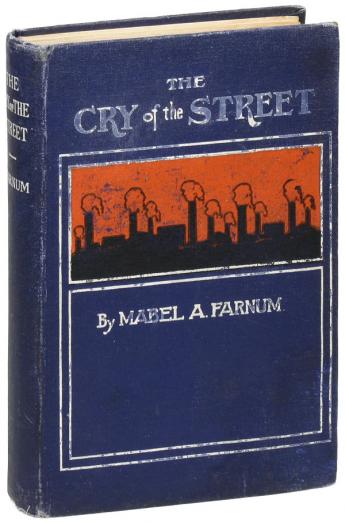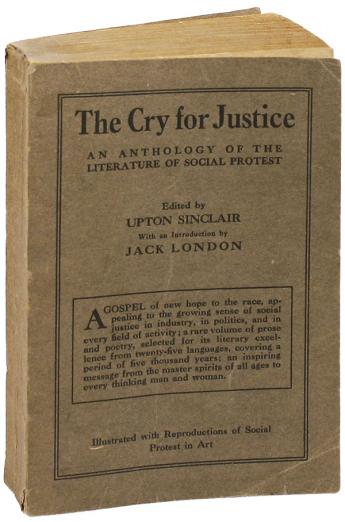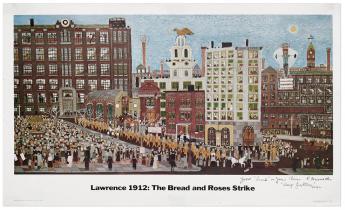Antiquarian Booksellers' Association of America Lorne W. Bair
Collecting Rare Books and First Editions - Bread & Roses: The Strike That Changed Everything

By Lorne Bair
January 11th marks the 101st anniversary of the beginning of the Lawrence Textile Strike, one of the signal events of 20th-century American labor history. This was the strike that put the IWW on the map, the strike that invented the moving picket line (to get around anti-loitering laws) and, most importantly, the first successful, large-scale strike in U.S. history to be carried out primarily by and on behalf of immigrant women. The Lawrence Strike has come to be known as the “Bread And Roses Strike,” because young women strikers were seen carrying banners that read, “We Want Bread, but Roses Too!,” quoting a line from James Oppenheim’s poem “Bread and Roses” (though labor folklore has attributed the source of Oppenheim’s poem to the Lawrence strike, it was actually written a year earlier, to commemorate the struggles of Chicago women workers). The poem was set to music in 1974 by Mimi Farina and has since become a labor-folk standard. Our favorite version is by the great Utah Phillips. Here it is.
The woolen mills of Lawrence, Massachusetts were by all accounts horrific places. Hard as it is for us to imagine today, the men and women who worked in them, mostly non-English speaking immigrants from Eastern Europe and Quebec, died at the average age of 26. The mortality rate for children under six was fully 50%. Loom operators were paid less than $10 a week — for 56 hours of work. They lived and worked completely at the whim of their employer, the American Woolen Company, subject to arbitrary layoffs and pay reductions at any time. So when, in January of 1912, the company announced that it would be reducing its workers pay by 32 cents a day — a reduction of more than 20% — the workers had finally had enough. They struck, and against all odds they won. They won despite the state’s trumped-up murder charge against the strike’s organizers, Joe Ettor and Arturo Giovannitti; despite violent suppression by the local militia, who in their noble attempt to preserve law and order turned fire hoses on the strikers in the heart of winter; despite the efforts of a local patriot who tried to frame the strikers by planting dynamite bombs around the city of Lawrence (he was an undertaker, so we assume a certain amount of self-interest may have guided his actions). Above all, they won because of the tenacious and novel strike tactics of the IWW, the most militant labor organization American has known before or since, especially under the leadership of the legendary Big Bill Haywood. The Wobblies took a sort of perverse pleasure in outwitting the (admittedly dim-witted) public officials of Lawrence, inventing such tactics as the “revolving picket line” to get around strict anti-loitering laws.
Needless to say, few strikes in American history have generated as much literature, music or folklore as did Lawrence. Given our interest in the art and literature of social movements, we’re unavoidably drawn to this material, as are our customers – it tends to come and go with some regularity. Here are a few recent acquisitions that are still with us, each interesting for its own reasons:
Hard to believe that a woman with sufficient intelligence and perspicacity to write a full-length novel on the subject could wind up so far on the wrong side of history, but that’s exactly what the devoutly Catholic author Mabel Farnum accomplished in her staunchly anti-labor novel about the Lawrence Strike, The Cry of The Street – a mill-town melodrama reminiscent of similar works such as The Factory Girl and Thrilling Events in the Life of Mira Dana, written in the mid-19th century. Fay Blake, whose The Strike in the American Novel (Metuchen: 1971) is by far the best study of its kind, calls Farnum’s novel “surprisingly old-fashioned” and “nonsensical,” but the novel illustrates what was certainly the majority view of Lawrence’s non-laboring citizens at the time of the strike.
The first book to conflate James Oppenheim’s 1911 poem “Bread and Roses” with the Lawrence Strike was Upton Sinclair’s 1915 anthology The Cry For Justice. It’s a key early work of American social protest literature, collecting “five thousand years of writing about the working man.” Sinclair’s hope was that this ”Socialist Bible” would supplant that of the Christians, but after years of looking I regret to say that I’ve never found a copy in a hotel dresser-drawer.
Pretty much from Day One, artists have attempted portrayals of the Lawrence Strike, including noteworthy drawings by such radical cartoonists as William Gropper and Fred Ellis. One of our favorites is this iconic 1977 painting by the self-taught New York painter and labor organizer Ralph Fasanella, who died in 1997. We’ve just catalogued this nicely inscribed poster reproduction, which came to us from a collection of radical graphics in the Bay Area.
And, finally, to anyone interested in reading a good, scholarly (if slightly partisan) account of the Lawrence Strike, we recommend William Cahn’s Lawrence 1912: The Bread & Roses Strike (New York: Pilgrim Press, 1980). We don’t have any copies in stock, but the book is easily available from many second-hand booksellers, including our pals at Bolerium Books in San Francisco.
(Posted on Minivan of the Revolution, presented here by permission of the author.)
You are looking for rare books on the history of America?


